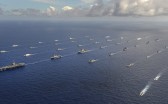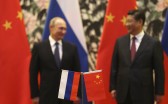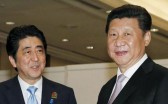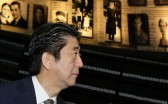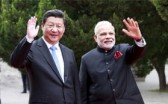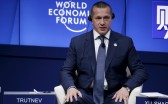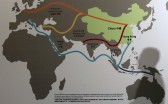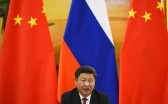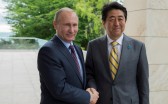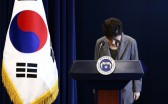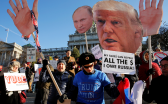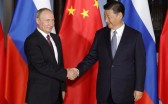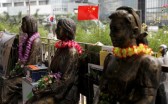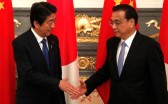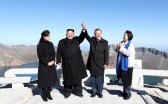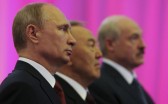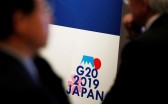Moscow continues to pursue irreconcilable policies globally and in Asia. As Anna Kireeva has written, Russian writers, if not the government, highlight an allegedly irreconcilable Sino-American rivalry to enhance Russia’s position in Asia. Moscow simultaneously holds out the hope that it can establish at least a long-term working relationship with Donald Trump’s administration on issues like Syria and Ukraine.1 Ideally, this would lead to US—if not Western – acceptance of Russia’s role in Syria and Ukraine and a supposed anti-terrorist collaboration that actually gives Russia a free hand on all issues it deems vital and revokes sanctions and its diplomatic isolation. Meanwhile, Moscow simultaneously claims to enjoy both its independence and a privileged relationship with China.2 Indeed, many Russian commentators as well as Vladimir Putin have argued for some time that Russia is undertaking or could undertake major economic projects in Asia and has chosen the right policy as expressed in Russia’s long-standing integration proposals for Eurasia from Lisbon to Vladivostok.3
Yet, a closer and deeper assessment of trends among the three states that comprise the vaunted “strategic triangle”—China, Russia, and the United States—suggests that Moscow is actually still deluding itself and misreading Asian realities while the United States and China, however spasmodically, are lurching towards the kind of relationship Moscow covets with Washington. The evidence for this conclusion stems from what the Belt and Road Initiative (BRI) summit revealed about Sino-Russian relations and developments concerning North Korea and relations among these three parties. Therefore, the official Russian optimism about Moscow’s Asia policy is quite misplaced. Indeed, it evokes Soviet socialist realism, which regularly appears in Russia’s Asian policy, and evidently represents a long-standing part of Russian political discourse whether or not it is justified.4
Reiterating delusional wish-fulfillment does not make it so except in Hollywood and in Broadway musicals. Dmitri Trenin, director of the Carnegie Endowment in Moscow, in 2015, celebrated the arrival of a Eurasian economic-political network stretching “from Shanghai to St. Petersburg.5 Yet, in June 2016 he wrote,
“The dream is over. Eurasia—as another name for the former Russian empire, then the Soviet Union, and finally the former USSR—is no longer useful as a description of a geopolitical and geo-economic region. Thus Russia stands alone, partly in Europe, partly in Asia, while the country itself belongs to neither.”6
Moreover, he admitted that one cannot discuss a Russian strategy for Asia but rather individual approaches to different states “that need to be harmonized.”7 The state cannot engender either a domestic or foreign-led transformation of Russia’s Far East (RFE).
Furthermore, Putin’s efforts in Beijing to subsume BRI within the framework of overlapping integration projects consonant with Moscow’s long-standing Eurasian integration vision reflected tired, old, and failed proposals that cannot be realized. Eurasian Economic Community (EURASEC), Moscow’s own regional economic bloc, faces formidable economic and political challenges. Russia’s declining economy has dragged down Central Asia with it and represented an effort to exclude China’s trade from Central Asia while forcing local consumers to pay more for inferior Russian goods. Even so, EURASEC clearly cannot compete with BRI and has had to accept subordination to it.8 Neither can it replace other major proposals for Asian economic integration like the abortive Trans-Pacific Partnership (TPP) or China-supported Regional Comprehensive Economic Partnership (RCEP).9 Recent Russian studies actually show that Russia benefits very little economically from EURASEC, and instead must subsidize some of the poorer members. Therefore, EURASEC will largely be a geopolitical not a geo-economic project, and, barring major reform, will have relatively little economic utility for Moscow.10 Indeed, EURASEC now faces great difficulties because the ruble’s devaluation has forced further devaluations across Central Asia and trade rows among its members that clearly have not benefitted them. EURASEC cannot serve as a panacea for retrieving Russia’s economic or political positions in either Central Asia or Asia.11 Neither can it be a platform for a major reordering of the international order even if buttressed by improved ties with major Asian powers.12 Members’ share in Russia’s trade only grew 0.5% from 2010 to 2016 while the dollar value fell from $64 billion to $39 Billion.13
Although EURASEC cannot be the engine of genuine geo-economic, let alone geopolitical, integration around Russia, which itself increasingly depends on Chinese investment and support, Putin advanced just such proposals in 2015 as a means of overcoming the economic crisis and the political isolation imposed upon Russia due to its aggression in Ukraine.14 Despite Moscow’s emphasis on transportation infrastructure investment from 2001 to 2011, the actual share of investments to transport and infrastructure remained at about 2.5% of GDP not the targeted 4%.15 Therefore, despite newly-announced plans to invest $43 Billion in a Europe-Asia Transport Corridor through China and Europe, where Russia plays a profitable but not directing role as a medium through which trade flows, it is by no means clear that Russia can realize its intentions as many such projects have been announced and failed since 1991.16
EURASEC is hardly a panacea for reestablishing Russia’s position, economic or political, either in Central Asia or the RFE.17 Putin’s invocation of it in an effort to display Russia’s continuing great power capabilities is, therefore, largely a mirage. Nor does China take seriously Russia’s pretensions, despite Moscow’s rhetoric.18 In 2014 Chinese investors announced interest in a high-speed Moscow-Kazan railway that would become the foundation of a railroad to Beijing. Yet, while the original MOU envisaged the railroad passing through Siberia, it was later revealed that the line would go instead from Astana, Kazakhstan’s capital, through Xinjiang, bypassing Russia and cutting travel time. And this is supposed to be a “model project of Russo-Chinese cooperation.”19 Meanwhile, other Sino-European trade options bypass Russia altogether going through Central Asia and the Caucasus. But since maritime intercontinental trade remains vastly cheaper than overland trade, land routes account for less than 1% of total cargo between China and Europe, greatly disadvantaging Russia.20
North Korea
The tangled Korea knot also reflects Russia’s futile efforts to assert itself as a great power. Moscow has, in the space of six weeks, offered to mediate between Pyongyang and Washington (and Seoul), opened a new ferry and developed other economic ties with North Korea, and urged it not to go nuclear while emphasizing, however, that actually Washington is trying to “intimidate” North Korea.21 Meanwhile, Washington and Beijing have announced their (seeming) cooperation on North Korea, for China clearly will not break with its past policy of upholding Pyongyang and remaining, despite its anger at North Korea’s continuing provocations, Pyongyang’s chief “enabler.”22 Russia’s seeming inconsistencies reflect its being torn between conflicting and contradictory impulses.
Russian policy has become steadily more anti-American and pro-Chinese since 2014 due to the aftermath of its invasion of Ukraine, Western sanctions, defense buildups, and accompanying political isolation. This has forced the Russian government and key interest groups into mounting dependence on China and support for Chinese policies in Asia to the degree that official criticism of China has been silenced.23 Second, Moscow continues to aspire to play an independent great power role in Asia and convince Washington of the need for recognizing it as an equal against China and terrorists, but so far to no avail. As part of that aspect of policy, Moscow negotiates with Japan over normalization, pursues arms sales, and offers trade deals with individual ASEAN members and between EURASEC and ASEAN.24 It also has sought to enlarge its influence in North Korea by a consistent program of increased economic ties to North Korea. Indeed, apart from the new ferry to and from Vladivostok and other activities in 2014-17, it is apparently supplying North Korea with ever more oil and coal at apparently subsidized prices.25
Yet, due to its dependence upon China against American threats and “arrogance,” Russia dare not make major concessions to Japan for normalization, support ASEAN on the South China Sea, refrain from growing economic dependence on China, or eschew convergent ideological positions against “color revolutions” with China. Although Chinese economic support has not been forthcoming to the degree Russia hoped for and there is growing Russian anger over this, Putin refuses to accept that China can be a threat and still believes that Russia benefits from China’s economic growth and that the strategic partnership is growing ever tighter.26
Consequently, Russian policy regularly oscillates among these three poles of support for China and North Korea against the United States, feeble and somewhat covert efforts to assert Russia as an independent and great power in Asia, and a recurring need to prove its bona fides to China to demonstrate that China needs Russia as an important ally against the United States. Hence, Russia upholds proposals to stand with China on behalf of North Korea, support BRI, refuse to grant Japan concessions that would actually further normalization, and lean to the Chinese side on the South China Sea.27 While China certainly wants Russian support, it is incontestably truer that today Russia needs China much more than it needs Russia.
Indeed, recent events show that if Beijing wants to draw nearer to Washington it need not take Russia into account. The recently announced trade deal between Washington and Beijing may not be important in overcoming their unresolved bilateral economic issues,28 but it contains a dagger drawn at the heart of Russia’s economic ties to Beijing, namely the announcement of US LNG exports to China.29 To the degree that this trade actually materializes, it will undermine one of the pillars of Russia’s economic ties to China. China will no longer have a Malacca problem that drives its security concerns to buy oil and gas from Russia lest its imports be blocked at the Straits of Malacca in the event of a crisis with the United States.30 Since it has long been known that Russo-Chinese energy negotiations are an unhappy affair with both sides suspecting the other of nefarious aims and conduct, a solid trading relationship with Washington would seem to be very much in China’s interest.31 Neither can Moscow do much about it.
Moscow too can negotiate directly with Washington on critical issues like Syria. But its attacks on the US and European elections, visible efforts to corrupt and subvert the US and allied governments, continuing aggression in Ukraine, violations of human rights and arms control treaties, support for the Taliban, and conduct in Syria all obstruct any kind of rapprochement with Washington. Moreover, the mounting domestic furor in the United States over the Trump campaign’s contacts with Russia and his ever more apparent efforts to cover them up indicate that there is unlikely to be any domestic support for rapprochement with Moscow. Indeed, quite the contrary is likely, despite Moscow’s persistence in working to bring about rapprochement. Every hint of cooperation with Moscow will encounter demands for investigations and venomous political attacks upon an administration that cannot offer a compelling rationale for making deals with a country that tried to corrupt its elections and attacks its interests globally.32 Trump conceded this when he said he fired FBI Director James Comey because of “the Russia thing” and that he thought that firing Comey eased the pressure on him vis-a-vis Russia so that he could make a deal with Moscow.33 Predictably, the exact opposite occurred. Apparently, Moscow has outsmarted itself. In any event, it is unlikely to be able to exploit Sino-US contradictions to convince either party to accept it at its own valuations. However, Moscow and its analysts attempt to spin these developments and trends, Russia’s economic and strategic failures are conjoined together and intrinsic to its mode of governance. Only when that changes will it be able to think anew and, even more importantly, act anew.
1. Anna Kireeva, “Positive Scenario, I,” The Asan Forum, vol. 5, no. 2, http://www.theasanforum.org/category/alternative-scenarios/?post_id=8244
2. “Заседание круглого стола лидеров форума «Один пояс, один путь,»,” May 15, 2017, http://www.kremlin.ru/events/president/news/54496,; “Ответы на вопросы журналистов,” May 15, 2017, http://www.kremlin.ru/events/president/news/54499,.
3. Ibid. Also see Vladimir Petrovsky, “Russia and Asia-Pacific Economic Integration: Seeking a ‘Point of Entry,’” Far Eastern Affairs 43, no. 4 (2015): 10; “Round Table: Relations Between the PRC and the U.S.A. At Present: Prospects and Challenges for Russia,” Far Eastern Affairs 43, no. 4 (2015): 57.
4. “Foreign Minister Lavrov’s Speech on Russia Policy in Asia-Pacific Region, Ties With Japan,” Ministry of Foreign Affairs, November 7, 2008; Foreign Broadcast Information Service Central Eurasia, (FBIS SOV), Open Source Committee, November 7, 2008; V. Kremenyuk, “U.S. Foreign Policy in a Presidential Election Year,” International Affairs, no. 5(2008): 47.
5. Dmitri Trenin, “From a Greater Europe To a Greater Asia?” http://carnegie.ru/2015/02/26/from-greater-europe-to-greater-asia/i327
6. Dmitri Trenin, “Russia’s Asia Strategy: Bolstering the Eagle’s Eastern Wing,” Russie. Nei. Visions, no. 94 (2016): 7.
7. Id. at 9.
8. Li Ziguo and Li Minjie, “Eurasian Economic Union: Achievements, Problems and Prospects,” China Institute of International Studies, August 19, 2016, http://www.ciis.org.cn/english/2016-08/19/content_8975486.htm
9. Tatiana Flegontova, “Russia’s Approach and Interests,” in Robert A. Manning, Chen Zhimin, Song Guoyong, Tatiana Flegontova, eds., Economic Order in the Asia-Pacific and Russian Interests, Discussion Club Report, March 2017, 9-12.
10. M. Bratersky, “Isolationism Versus Geopolitics: The Dual Role of the Eurasian Union In the System Of global Governance,” International Organizations Research Journal 11, no. 2 (2016): 43-51; I. Andronova, “New Mechanisms For International Cooperation: Opportunities and Challenges: Eurasian Economic Union: Opportunities and Barriers To Regional and Global Leadership,” International Organizations Research Journal 11, no. 2 (2016): 7-19.
11. Sibren De Jong, “Why Countries Are Not Rushing To Join Putin’s Union,” Euobserver, May 27, 2016; “Is Kazakhstan Getting Eurasian Union Blues?” Eurasia Insight, March 9, 2016.
12. “Пленарное заседание Петербургского международного экономического форума,” June17, 2016, http://kremlin.ru/events/president/news/52178,
13. Anton Barbashin, “Russia’s Slow Pivot Away from Europe,” Intersection: Russia/Europe/World, March 24, 2017, http://intersectionproject.eu/article/russia-europe/russias-slow-pivot-away-europe.
14. “Plenary Session of the 19th St. Petersburg International Economic Forum: Speech by President Vladimir Putin At the Plenary Session of the St. Petersburg International Economic Forum,” June 19, 2015.
15. Katri Pynnoniemi, “Much Ado About Nothing: The EU’s Transport Dialogue with Russia,”Finnish Institute of International Affairs, Briefing Paper no. 81, 7.
16. Kira Kalinina, “Russia To Invest $43BLN In Europe-Asia Transport-Corridor,” Russia Beyond the Headlines, March 2, 2017.
17. Sibren De Jong, “Is Kazakhstan Getting Eurasian Union Blues?” Eurasianet.org, March 9, 2016.
18. Kathryn Hille and Charles Clover, “Putin-Xi Embrace Masks ‘Belt and Road’ Concerns,” Financial Times, May 15, 2017, 4.
19. T. Bordachev, A. Kazakova, A. Skirba, “Institutions For a Peaceful Eurasia,” International Organizations Research Journal 11, no. 2 (2016): 20-28; I. Makarov and A. Sokolova, “Coordination of he Eurasian Economic Union and the Silk Road Economic Belt: Opportunities For Russia,” International Organizations Research Journal 11, no. 2 (2016): 33-34.
20. Ibid.
21. “Ответы на вопросы журналистов,” May 15, 2017, http://www.kremlin.ru/events/president/news/54499
22. North Korea may even be using China’s satellites to provide data for its missile tests. See Peter J. Brown, “Is North Korea Using China’s Satellites To guide Its Missiles?” Asia Times Online, May 24, 2017.
23. Alexander Gabuev, “Deciphering China’s Security Intentions In Northeast Asia: A View From Russia,” in Gilbert Rozman, ed., Joint U.S.-Korea Academic Studies: Rethinking Asia In Transition: Security Intentions, Value Gaps, and Evolving Economic Relations, (Washington, D.C.: Korea Economic Institute of America, 2016), 60-65.
24. Ekaterina Koldunova, “Russia’s Involvement in Regional Cooperation in East Asia: Opportunities and Limitations of Constructive Engagement,” Asian Survey 56, no. 3 (2016): 539-43; “Moving Towards a Strategic Partnership for Mutual Benefit,” Sochi Declaration of the ASEAN-Russian Federation Commemorative Summit to Mark the 20th Anniversary of ASEAN-Russian Federation Dialogue Partnership, May 20, 2016.
25. Liudmilla Zakharova, “Russia-North Korea Economic Relations,” in Gilbert Rozman, ed., Joint U.S.-Korea Academic Studies: Rethinking Asia In Transition: Security Intentions, Value Gaps, and Evolving Economic Relations (Washington, DC: Korea Economic Institute of America, 2016), 211-224; Paul Goble, “Russia Supplying North Korea with Ever More Coal and Oil, Moscow Business Paper Says,” Window on Eurasia, May 23, 2017, http://windowoneurasia2.blogspot.com/2017/05/russia-supplying-north-korea-with-ever.html; Paul Goble, "Russia Opens Passenger and Cargo Shipping Service between Vladivostok and North Korea,” Window on Eurasia, May 19, 2017,http://windowoneurasia2.blogspot.com/2017/05/russia-opens-passenger-and-cargo.html.
26. Gabuev, 60-65; Заседание круглого стола лидеров форума; “Ответы на вопросы журналистов,” May 15, 2017, http://www.kremlin.ru/events/president/news/54499,
27. Stephen Blank, The Negative Scenario I,” The Asan Forum 5, no. 2 (March-April 2017); Stephen Blank, ”Sino-Russian Relations and the Failure of Russo-Japanese Relations,” The Asan Forum 3, no. 6(November-December, 2015).
28. Takeshi Kawanami and Issaku Harada, “In Sharp Reversal, Sino-American Trade Relations Improve,” Nikkei Asian Review, March 13, 2017, http://asia.nikkei.com/Politics-Economy/International-Relations/In-sharp-reversal-Sino-American-trade-relations-improve.
29. Pablo Martinez Montsivais, “Trump Follows Obama’s Lead on Natural Gas Exports,” Axios, May 12, 2017; ”Update: U.S. Allows LNG Exports To China,” Natural Gas World, May 12, 2017.
30. “China Eyes U.S. Energy After Inking $20 Billion In Deals,” Bloomberg News, May 14, 2017.
31. Agnia Grigas, The New Geopolitics of Natural Gas (Cambridge, MA: Harvard University Press, 2017), 258-61.
32. Matt Apuzzo, Maggie Haberman, and Matthew Rosenberg, “Trump Told Russians That Firing ‘Nut Job’ Comey Eased Pressure From Investigation,” The New York Times, May 22, 2017.
33. Ibid.
